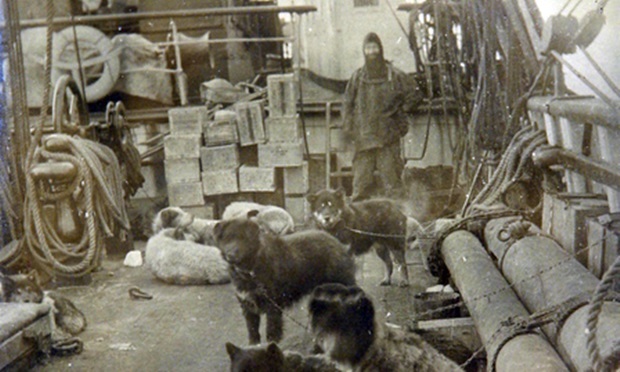A rare collection of photographs taken during Captain Scott’s doomed South Pole expedition have fetched hundreds of pounds at auction in New Zealand.
The series of nine black and white pictures went under the hammer at Cordy’s Auctioneers in Auckland, going for almost double their reserve of 850 New Zealand dollars approximately £750.
The lead stoker on the Terra Nova, teenager Edward ‘Mac’ McKenzie, lied about his age to enter the navy. He took the photos during the 1910-13 voyage to the white continent, the New Zealand Herald reported.
The collection includes several dramatic shots of the Terra Nova trapped in ice, a crew member on skis surrounded by penguins, and a view of the deck complete with dogs, supplies and an unidentified man.
A receipt included in the collection comes from the Canterbury Museum, which is dated 1972 and acknowledges, “Collection of Glass Negatives taken on the Terra Nova Expedition (1910-12) by E.D. McKenzie, leading stoker”.
The Terra Nova expedition has links to New Zealand, with the ship sailing from Lyttelton, bound for Antarctica, on December 15 1911.
On board was Captain Robert Falcon Scott who was bidding to be the first man to reach the South Pole. Having been beaten to the accolade by Roald Amundsen, he and his party died returning to base.
The world was informed of the tragedy when Terra Nova reached Oamaru on February 10 1913.
During the voyage McKenzie documented everything he saw through his journal and camera.
In his journal which was not included in the sale McKenzie wrote of hearing the fateful news that the crew had all perished.
The note said: “Jan 18th. Ship enters McMurdo Sound arriving off Cape Evans at 2pm cheese was exchanged between ships and shore parties.
“Commander Evans hailed Lieut Campbell and asked if all was well, we were completely horrified to hear in answer that the southern Party consisting of Capt Scott, Capt Oates, Dr Wilson, and Lieut Bowers, also Petty Officer Evans, had been lost on their return from the pole.”
On his return to Britain, McKenzie made a 3m working model of the Terra Nova that was used in shots in John Mills’ 1948 film about the expedition, Scott of the Antarctic.
A REMINDER OF DUNDEE’S SHIPBUILDING PAST
Terra Nova was a whaler and polar expedition ship best known for carrying the ill-fated 1910 British Antarctic Expedition, Captain Robert Falcon Scott’s last voyage.
Built in 1884 by Dundee shipbuilders Alexander Stephen and Sons for the local whaling and sealing fleet, Terra Nova was ideally suited to the polar regions.
The vessel worked for 10 years in the seal fishery in the Labrador Sea, proving its worth for many years before it was called upon for expedition work.
In 1903, it was sailed in company with fellow ex-whaler SY Morning to assist in freeing Scott’s RRS Discovery from the frozen ocean at McMurdo Sound.
In 1909, Terra Nova was bought by Captain Scott for the sum of £12,500, for the upcoming British Antarctic Expedition.
Reinforced from bow to stern with seven feet of oak to protect against the Antarctic ice pack, it sailed from Cardiff Docks on June 15 1910.
After returning from the Antarctic in 1913, Terra Nova was purchased by her former owners and resumed work in the Newfoundland seal fishery.
In July 2012, the wreck of Terra Nova was discovered by the Schmidt Ocean Institute’s flagship RV Falkor.
